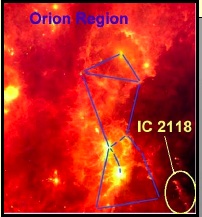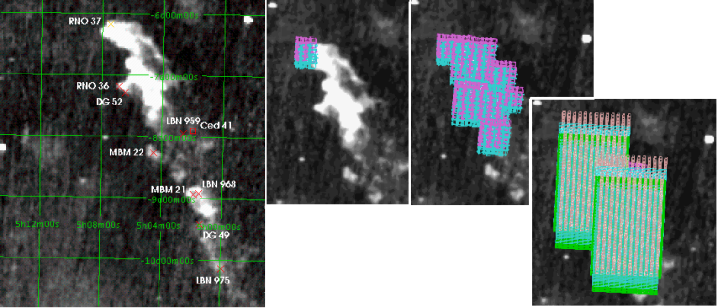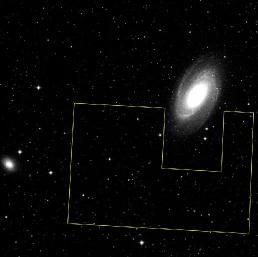Difference between revisions of "Current Research Projects"
| Line 1: | Line 1: | ||
=[[Young Stars in IC 2118]]= | =[[Young Stars in IC 2118]]= | ||
| − | [[Image:ic2118iras.jpg|right]]IC 2118, the Witch Head Nebula (~210 parsecs [A parsec is a unit of distance equal to 3.26 light years. So 210 pc = 685 light years.]), is a star forming region near the supergiant star Rigel in the constellation Orion. In the image at the right (taken by IRAS at 25 microns), IC 2118 is the structure at the bottom right corner. Rigel appears to be at least partially responsible for exciting and blowing off a significant portion of the nebula in this region. | + | [[Image:ic2118iras.jpg|right]]'''CLICK ABOVE for current research activities associated with ths project.''' |
| + | |||
| + | IC 2118, the Witch Head Nebula (~210 parsecs [A parsec is a unit of distance equal to 3.26 light years. So 210 pc = 685 light years.]), is a star forming region near the supergiant star Rigel in the constellation Orion. In the image at the right (taken by IRAS at 25 microns), IC 2118 is the structure at the bottom right corner. Rigel appears to be at least partially responsible for exciting and blowing off a significant portion of the nebula in this region. | ||
What we are trying to do is characterize the process of pre-main sequence stellar evolution in this cluster. We want to be able to compare star formation in this cluster with others to see if there are similarities or differences. | What we are trying to do is characterize the process of pre-main sequence stellar evolution in this cluster. We want to be able to compare star formation in this cluster with others to see if there are similarities or differences. | ||
Revision as of 21:24, 13 July 2007
Contents
- 1 Young Stars in IC 2118
- 2 Observing Iron Stars with Spitzer
- 3 Intergalactic Star Formation in Tidal Dwarf Galaxies of M81
- 4 AGN Spectral Energy Distributions of GLAST Telescope Network Program Objects
- 5 The Supermassive Black Hole in Arp102B
- 6 Detecting Brown Dwarfs in Interacting Cataclysmic Binaries
- 7 Star Formation in High Redshift Clusters with Spitzer
Young Stars in IC 2118
CLICK ABOVE for current research activities associated with ths project.
IC 2118, the Witch Head Nebula (~210 parsecs [A parsec is a unit of distance equal to 3.26 light years. So 210 pc = 685 light years.]), is a star forming region near the supergiant star Rigel in the constellation Orion. In the image at the right (taken by IRAS at 25 microns), IC 2118 is the structure at the bottom right corner. Rigel appears to be at least partially responsible for exciting and blowing off a significant portion of the nebula in this region.
What we are trying to do is characterize the process of pre-main sequence stellar evolution in this cluster. We want to be able to compare star formation in this cluster with others to see if there are similarities or differences.
Previous all-sky surveys, including both IRAS and 2MASS, have included this region, but not to the resolution or the wavelengths that Spitzer can provide, and there are few studies of this particular region in the literature.
In our first observation of this region, we selected a target area based on the IRAS survey and recent work conducted by Kun et al. (2004). Our Spitzer time was limited so we selected an area of the cloud that had a known IRAS source and 3 possible new classical T Tauri stars that were identified by Kun. The image on the left shows the region of IC 2118 (in IRAS 25 micron, with the proposed observations overlaid). The target center coordinates are RA 5h 2m 0.0s, DEC –8d 52m 54.0s. In our second observation of this region, we were granted 11.5 hrs to go as far down the cloud as we could. We went about 2.5 degrees down the cloud.
On the left, previously known objects in this region are indicated in red. In the center, the first year's coverage using IRAC is indicated. On the right, you can see the second year's coverage using IRAC (cyan and magenta) and MIPS (pink, blue, and green).
Members of the team visited the Spitzer Science Center (SSC) to work with Dr. Rebull in the reduction of the data during the summer of 2005 and 2006. We have a source list data table that includes 2MASS (J, H, and K band), IRAC (3.6, 4.5, 5.8, 8 µm), and MIPS (24 and 70 µm) fluxes in both magnitudes and Janskys.
The table of stellar brightness at different wavelengths can be used to:
1. generate spectral energy distributions (SEDs), which allow us to tell at a glance if the star has excess emission (such as that from a disk). We can approximate the temperature of a star by fitting a blackbody curve to its SED.
2. make IR color-color plots that can be used to find young stars and hopefully determine the age of stars.
The mosaics that can be created by overlapping images collected at different wavelengths (like the one used in this Wiki's logo) are used to determine the structure of the ISM.
The scientist working on this project is Dr. Luisa Rebull; she is a staff scientist at the Spitzer Space Center. Luisa’s main area of interest is properties of young stars. She is particularly interested in finding out about how a star’s rotation rate, disk, and accretion rate change over time.
Luisa thinks it’s very important to spread the word about astronomy to lots of different people. She has given presentations to groups from all over California. In fact, she has received awards for her outreach efforts. You are going to learn a lot working with her!
The teachers working on this project are:
| Teacher Name | School Name | Location |
|---|---|---|
| Timothy Spuck | Oil City Area Sr. High School | Oil City, PA |
| Babs Sepulveda | Lincoln High School | Stockton, CA |
| Theresa Roelofsen | Bassick High School | Bridgeport, CT |
| Cynthia Weehler | Luther Burbank High School | San Antonio, TX |
| Tony Maranto | Phillips Exeter Academy | Exeter, NH |
Observing Iron Stars with Spitzer
Intergalactic Star Formation in Tidal Dwarf Galaxies of M81
The M81 galaxy group consists of several interacting galaxies, including M81, M82, NGC 3077, and NGC 2976, (the picture to the right shows NGC 3077 and M81). (M stands for Messier Object, and NGC stands for New General Catalogue. Charles Messier catalogued objects in the night sky that weren’t comets or obvious stars, and M81 was the 81st item on his list. The NGC is simply another catalogue of dimmer objects in the night sky, such as galaxies, star clusters and nebulae.)
Scientists are interested in studying interacting galaxies because there is evidence that gravitational interaction can lead to weird galaxy shapes (called peculiar galaxies -- if you want to see some peculiar Galaxies, do a web search for "Arp Catalogue of Peculiar Galaxies"), dwarf galaxies and unusual trails of stars and ISM (interstellar medium -- "Interstellar medium" literally means stuff-between-the-stars; its really just clouds of dust, gas and molecules. ISM sounds more impressive than stuff-between-the-stars though. So now you can sound smart too and say ISM instead.). These stretched out trails are called tidal tails (a good way to think about tidal tails is think of a long trail of stars and stuff that is pulled off from the main galaxy arms by gravity). A group of scientists, Gordon et al. (Anytime you see a name followed by "et al.", it just means that there was more than one scientist working on the project. So Gordon et al. just means that a scientist whose last name is "Gordon" studied something with a bunch of his/her buddies "et al." Get it? Sometimes you see it with a date, Gordon et al. 2004, which just means the paper Gordon wrote with his/her buddies in 2004. Then you go look at the reference list to see which paper they wrote. Now you can look all smart and write that in your papers!) have already used Spitzer to acquire IR images of most of the M81 galaxy. Their data show that the galaxy has tidal tails with numerous bright star-forming regions and lots of cold dust.
Meanwhile, another group of scientists (Durrell et al. 2005; see http://www.astro.psu.edu/users/pdurrell/M81/pr.html for the original version of these images) was studying M81 from Earth (using the CFHT- Canada France Hawaii Telescope). At a visual wavelength, they observed two small 'clumps' of bright blue stars. These are newly discovered clumps in one of the tidal tails of M81! They are so new that we're not even sure what these objects are! They might be newly formed dwarf galaxies or may be stars that are forming outside the galaxy.
These scientists have estimated the age of those clumps at 100 million years old; which is over 200 million years after the date that most scientists think the last main M81 galactic interaction happened. It would be great to be able to compare the optical images of the newly discovered objects with other wavelengths, but unfortunately all of the existing Spitzer IR images of M81 didn’t include the coordinates of the objects found by Durrell et al. In other words, we have IR images of most of M81, but there aren’t any Spitzer IR images of the specific areas in the tidal tails where these new objects are located.
So, when the Spitzer Teachers involved found out about these new objects and the fact that Spitzer didn’t have pictures of them, we decided to write a proposal to extend the area of existing Spitzer M81 observations to include the coordinates of these recently discovered objects. We hope to show that the objects are in fact tidal dwarf galaxies (TDGs). We also want to compare the stellar formation in these potential TDGs with the disk of M81 to determine if the process of star formation is different in debris tails.
M81 is a relatively close galaxy: it’s only 12 million light years or 3.6 Mpc (megaparsecs -- Go grab a calculator: A megaparsec is 1,000,000 parsecs. 1 parsec= 3.26 light years. So if M81 is 3.6 Mpc away it is around 11.7 million light years from us. Wow. That means the light you are seeing left M81 a little less than 12 million years ago! And that’s considered close! The universe is a big place.). That makes M81 (and these little TDG’s) an ideal target for the study of the formation of stars due to galactic interaction. So the real goal here is to compare the possible differences between star formation conditions in TDGs with big galaxies (galactic disks). We are going to use a specific camera on Spitzer (called IRAC) to look for molecules called PAHs (remember we mentioned them earlier?) If we find PAHs in that area, it would mean that we’ve found dust in the debris tails. We are also going to use a different camera on Spitzer called MIPS to estimate the temperature of this dust. Once we have all that data, we will then compare it to the existing observations of M81 by other scientists (Willmer et al. and Gordon et al). If all goes well, we should be able to compare the star formation properties of the TDGs with the galaxy M81. In other words, we’ll be able to compare how stars form inside galaxies with how they form in tidal tails. Neat, isn't it? The M81 project includes five teachers and their students from all over the country! There are five teachers (listed below) and their students (you might be one!) Also along for the ride are two fabulous scientists: John Feldmeier (a collaborator in the Durrell et al. paper, from NOAO) and Varoujan Gorjian (from SSC). Both scientists will be there to help us interpret the data and give us lots of help.
The teachers working on this project are:
| Teacher Name | School Name | Location |
|---|---|---|
| Theresa Roelofsen Moody | New Jersey Astronomy Center for Education | Somerville, NJ |
| Timothy Spuck | Oil City Area Sr. High School | Oil City, PA |
| Babs Sepulveda | Lincoln High School | Stockton, CA |
| Cynthia Weehler | Luther Burbank High School | San Antonio, TX |
| Linda Stefaniak | Allentown High School | Allentown, NJ |


